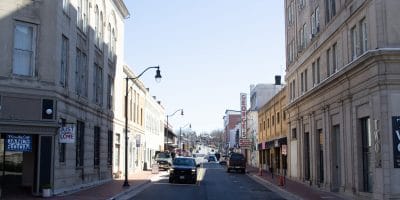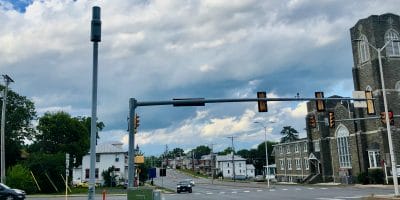
Community Perspective submission by Bill Cale
I love trees. In fact, I consider them my friends. When I moved to Harrisonburg, Susan and I considered only houses adjacent to forests. In the Shenandoah Valley, those of us who live here find ourselves in the Appalachians, a range of mountains that includes many ridges and valleys. The flora is phenomenal! Our region is said to have the largest number of tree species in the entire world!
Yet, trees are under assault. The small ridge on which my present house stands was, for some reason, full of a linear profusion of Green Ash trees, which stretched perhaps a mile with part of that course in the neighboring city park and marched through my adjacent property.
Around 2014, I read about the Emerald Ash borer, which was devasting the ash trees of the northern Midwest and was reported to be spreading. Aware of the spread of previous tree epidemics, most notably the American Chestnut, I was alarmed that my property contained many of these at-risk ash trees. I knew it was only a matter of time until it struck here with its fury, leaving behind dead hulks, after the larvae of the Emerald Ash Borer gnawed through the cambium. It is manifest with “blonding” seen at first on the upper trunk and branches followed by the bark shedding and destruction of the trees one-by-one in the forest. It has marched throughout the range of the trees to the extent that the manufacturers of the Louisville Slugger, originally made of ash wood, can no longer be reliably supplied with the wood because of the devastation. Baseball bats, originally made of ash, now are made of maple or metal. The epidemic has now reached our forests with full fury.
But the disappearance of whole species of trees has occurred without notice to most folks. Few people know of the butternut or white walnut tree whose wood was used for beautiful furniture in the early history of this country. Its unique beauty could be seen in its close grain and its deep, almost 3-D like quality which enticed one to dive deeply into its “pool,” when finished by early craftsmen. Then there is the American Chestnut tree. I remember both of these trees mostly as rotting hulks on the ground.

The American Chestnuts, at maturity were gigantic, the largest in the eastern forests and supplied a livelihood for mountaineers in our local ranges, the Blue Ridge on the east and Shenandoah Mountain on the west and the iconic Massanutten bisecting the mid-valley with its southern terminus at the “peak” looking like the head of a reclining tyrannosaurus rex. I have imagined this green tree-covered ridge, dappled by alternating dark green evergreen pines and hemlocks and lighter green deciduous trees, as the reclining beast with its head at the Massanutten Resort with the brow of the beast hosting the top of the ski lift. The tessellated, long and bumpy projections of the ridge, a 3-D neck joins the “head” to the “shoulder” at Laird’s Knob and the rump, the end of Laird’s Knob, and the tail stretching beyond visibility to the north.
The “fruit” of the Chestnut growing on these three ridges was food for humans and animals, the tannin bark used for tanning, the wood for building furniture and the river rafts for early commerce on the Shenandoah River. A whole economy was lost with the disappearance of the Chestnut. The white walnut or butternut is almost impossible to find in the south now because of, you guessed it, an introduced fungus from Asia, and similarly, the American Chestnut is now impossible to find except for little sprigs that still come up from the roots. The Canadian Hemlock, formerly very prolific in mountainous areas of the south is disappearing. It has been attacked by the wooly adelgid an insect from Asia once again. The large stand of 800-year-old hemlocks once present around the White Oak Canyon Trail in the Shenandoah National Park have now all died from the assault.
There is hope for the return of the chestnut with genetic engineering. If you are lucky, you can get the seedling to plant. Perhaps one day forests will again host this beautiful and very economically valuable tree. Who can forget the coarse grain furniture that was mass produced and the wormy chestnut furniture that was “pock-marked” by little round holes? But the blight introduced from the Far East, not only virtually wiped out the “spreading Chestnut” that sheltered the “village smithy,” but also had provided a valuable source of lumber.
The assault has come from the Far East. With its huge landmass and species diversity, Asia has produced disease and pestilence in its forests, which have spread to our shore, where there are trees with no resistance. The variety of our flora is in danger of becoming poorer as species after species has infested and invaded. Gypsy moth chomping through oak forests though halted, wooly adelgid destroying the Canadian Hemlocks and other species, large leaf elm beetle literally defoliating these trees, scab attacking the Dogwoods and Serviceberry, the lantern fly attacking multiple tree species, as well as crops serve as threat examples, and finally, the emerald ash borer, which I am personally battling.
A temple is supposedly a microcosm of an ideal world with divine implications. My temple of trees is a two-acre plot adjacent to my house with native azaleas planted to host the larvae of the yellow swallowtail butterfly, is enfenced to protect wild flower plantings and tree seedlings from the deer. It is a sanctuary of solitude and quiet where Susan and I can find peaceful solace. We have removed invasive vines and plants and replaced them with natives.
My campaign has involved just trying to be realistic in the ongoing battle. While most of the ashes are dead and dying in adjacent Westover Park, they survive in my fenced-in two-acre area adjacent to my house and lot. Susan and I have determined we would treat this area and, with the city’s permission an adjacent area of woodland we formerly owned and donated to the city for bike and hiking trails. So far, we treat approximately 90 ash trees with either direct systemic injection or soil infusion around the tree base. This must go on, in perpetuity or at least until the pesky ash borer moves on or another approach works. So far, our treated green ashes are thriving, while those in Westover Park are dying in large numbers. We have noticed our trees are visibly larger now with some reaching over 30 inches in diameter.
Currently, we are continuing to protect a number of at-risk tree species, such as the green ash trees, the elms, the fringe trees, the dogwoods, and the service berries. What will we do when more trees are at risk from the spotted lantern-fly which attack multiple tree species? It is a continuing assault which we will defend against as long as we are alive. While it does not yet approximate what our forefathers saw when they encountered the vast forest, one gets a sense of awe that they must have felt by a stroll in our temple.
Bill Cale is not professional musician without any pretentions as such, but has a love particularly for singing Lieder. In the 1980’s, he did solo work with the Shenandoah Valley Choral Society. Last concert was with Gabriel Dobner in March of 2016 for the RMH Foundation. Has sung in First Presbyterian choir. Bill has his board certification in Internal Medicine Pulmonary, Critical Care and Sleep Medicine. He is a Fellow of the American College of Chest Physicians and the American Academy of Sleep Medicine, and has held past directorships of Respiratory Therapy, Critical Care, and Sleep Center at Sentara RMH.












